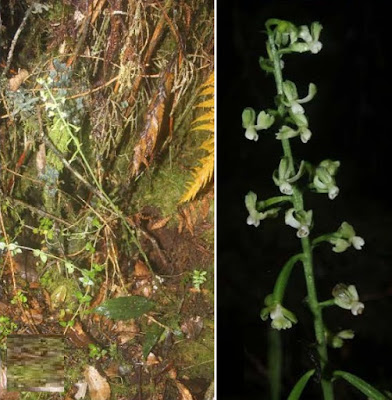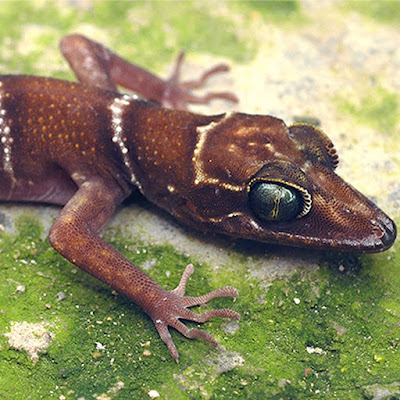[Most Recent Entries] [Calendar View]
Friday, August 4th, 2017
| Time | Event | ||||
| 4:44a | [Botany • 2017] Calanthe cootesii • A New Species (Orchidaceae; Epidendroideae; Collabieae) from the Southern Philippines
Abstract Calanthe cootesii M.A. Naive from Mt. Maagnaw, Kitanglad Mountain Range, Bukidnon, is described and illustrated. Morphological diagnostic characters of related species of the genus are discussed. Though similar to C. brassii Ormerod, the new species is clearly distinguished by having a marked difference in the shape of the lip and the reflexed and recurved floral segments. It is also allied to C. davaensis Ames, but the new species is clearly distinguished by having smaller and greenish flowers with an indistinct spur. Keyword: Bukidnon, Calanthe cootesii, Kitanglad Mountain Range, Mt. Maagnaw, New species, Orchidaceae, Philippines
Calanthe cootesii M.A. Naive, sp. nov. Type: PHILIPPINES, Northern Mindanao, Bukidnon, Kitanglad Mountain Range, Mt. Maagnaw, terrestrial in mossy forest with deeply shaded locations and humid environments along the trail, elevation 2645 m, 15 April 2017, M.A. Naive 016/2017 (HOLOTYPE: CMUH00010871 with spirit collection) Diagnosis: Calanthe cootesii M.A. Naive is similar to Calanthe brassii Ormerod, however, it can be recognized by having a marked difference in the shape of the lip, and the midlobe which is short, bilobed and triangular. It also differs in having revolute and reflexed floral segments and by having a slightly reclinate pedicel and ovary. By having a revolute and reflexed sepals and petals, C. cootesii is allied to Calanthe davaensis, but differs significantly in smaller and greenish flowers, the shape of the floral segments, and the leaves. Also, C. cootesii is clearly distinguished from C. davaensis by having an indistinct spur (vs. distinct spur). Etymology: Named in honour of my mentor, Jim Cootes, a distinguished Philippine native orchid expert and taxonomist. Ecology: Calanthe cootesii is a terrestrial understory herb, growing in leaf litter, humus-rich soils in mossy forest at an elevation between 2600–2700 metres above sea level. Distribution: Calanthe cootesii is a local endemic species, only collected at the type locality in Mount Maagnaw, Kitanglad Mountain Range, Bukidnon, Northern Mindanao, Philippines. Mark Arcebal K. Naive. 2017. Calanthe cootesii sp. nov. (Orchidaceae; Epidendroideae; Collabieae): A New Species from the Southern Philippines. Taiwania. 62(3);331-334. DOI: 10.6165/tai.2017.62.331 | ||||
| 2:11p | [Herpetology • 2017] A Re-evaluation of the Phylogenetic Relationships of the Cyrtodactylus condorensis group (Squamata; Gekkonidae) and A Suggested Protocol for the Characterization of Rock-dwelling Ecomorphology in Cyrtodactylus
Abstract A re-evaluation of the phylogenetic relationships of the four species of the monophyletic Cyrtodactylus conodorensis group using the mitochondrial gene ND2 with Bayesian and Maximum Likelihood analyses provides strong statistical support for the recovery the cave-adapted ecomorphs C. eisenmanae and C. grismeri as the sister lineage to the scansorial forest-adapted ecomorphs C. condorensis and C. leegrismeri. This phylogeny provides the context in which these ecomorphs are morphologically characterized. The majority of newly described species within Cyrtodactylus have come from karst habitats and granite boulder cave-like microhabitats. Although some authors have commented on subtle to notable differences in the morphology and color pattern associated with species from these habitats, none have explicitly presented data necessary to characterize this putative departure from a more generalized, scansorial morphology. To this end, the closely related species of the condorensis group are used to provide a suggested protocol to recover and delimit characters adaptive to a restrictive lifestyle of climbing on flat, rocky substrates in low levels of illumination. Understanding the phylogenetic context in which a morphological shift from a general scansorial species to a rock-adapted species relative to the historical evolution of its environment has conservation and management implications. This is particularly important given that a number of the newly described karst-adapted species from throughout Southeast Asia are threatened with extension because of the ongoing quarrying activities of their habitat. Keywords: Reptilia, Cyrtodactylus, ecomorphology, cave, karst, islands, conservation, Vietnam L. Lee Grismer and Jesse L. Grismer. 2017. A Re-evaluation of the Phylogenetic Relationships of the Cyrtodactylus condorensis group (Squamata; Gekkonidae) and A Suggested Protocol for the Characterization of Rock-dwelling Ecomorphology in Cyrtodactylus. Zootaxa. 4300(4); 486–504. DOI: 10.11646/zootaxa.4300.4.2 |
| << Previous Day |
2017/08/04 [Calendar] |
Next Day >> |






